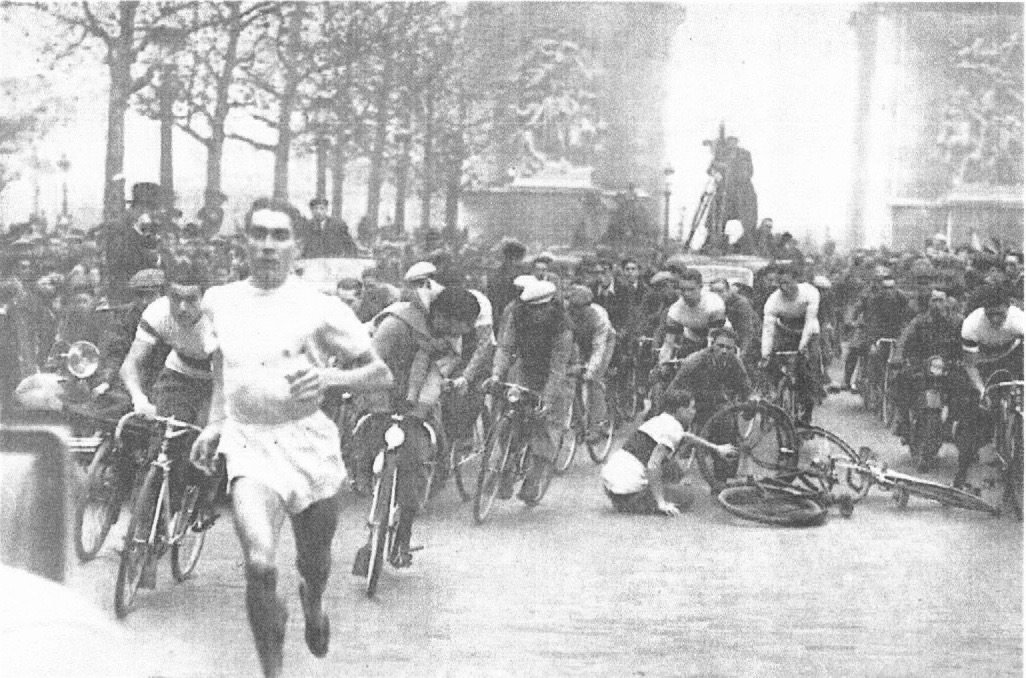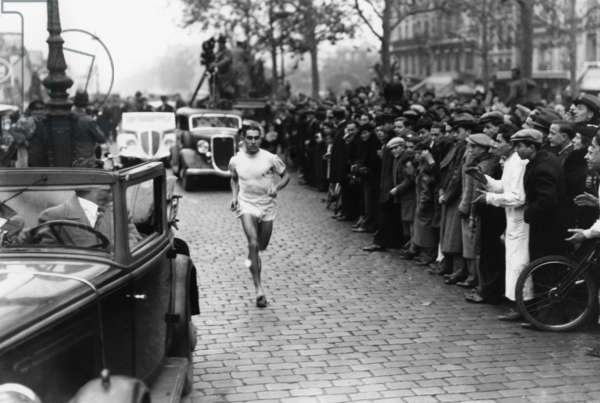 |
Parades across the world are often military, the Russian May Day Parade for example. But there are many other types of parade—processions of people along a road that celebrate historical events (the end of World War 2) or promote groups of society (the Brazilian Rio Carnival Parade). And of course there is always a Parade of Nations to open the Olympic Games.
A unique parade was held in Paris, France, on November 11, 1935. It was organized by the newspaper Paris-Soir to pay homage to a runner who had been banned for life some four years previously. Jules Ladoumègue had captured the hearts of his nation when he had broken six world records and won an Oålympic silver medal. A very sensitive and modest man, “Julot” nevertheless appealed to the French, who were still recovering from German occupation in World War 1. He also appealed to the public with his elegant running style.
In the days before November 15, Paris-Soir promoted this parade: “All the champions, all the stars, all the sportsmen will march in procession tomorrow for Ladoumègue. At 10:15 the great French champion will run the Paris route from Porte Maillot to the Concorde. This 3K route will include the length of the famous Champs Elysées.”
Due to the effective promotion of this parade—and of course thanks to “Julot’s” popularity--the event was hugely successful. The turnout was estimated to be between 300,000 and 400,000. Paris-Soir estimated the higher figure. And although carefully organized, the parade became so chaotic that Ladoumègue, as he described later in his book Dans ma foulée, was barely able to complete the course.
Below is the passage recounting his experience. He managed to run fast and show off the famous style, despite the difficulties he had in completing the 3K course. He describes the exhaust he had to breathe in, and the chaos of people, and bicycles and vehicles. “My run was acrobatic,” he writes.
 |
From Jules Ladomègue, Dans ma foulée (1955), pp. 173-5
On November 11, 1935, I had to perform the most beautiful run of my life. I say beautiful because I ran it in the heart of France. Gaston Bénac took a chance on that day to achieve the greatest public athletic success. Paris-Soirundertook the organization; the press adopted the project with a touching solidarity. Parisians were invited to come and demonstrate against the bias in the Federation [the Federation that had banned Ladoumègue for life] and to express their sympathy for me.
Charles Poulenard, one of those who didn’t accept my disappearance [from international athletics] easily, came to find me at 08:00. I had to be at Porte Maillot at 09:00, but I couldn’t make it till 09:30. I was hidden under a blanket in Georges Carpentier’s vehicle. He couldn’t clear a path because of his own celebrity status—and also because from the Place de Concorde to the Porte Maillot, a distance of about 3K, there were 300,000 people. From time to time I risked a peep and then covered myself again in fear. We finally arrived at the rendez-vous.
There was a great shout! The orderly process, although extremely important was overwhelmed, and the vehicle invaded. Berretrot, with a loudspeaker that resembled a pavilion of phonographs, was trying out his legendary voice. The news correspondents were working with their sleeves rolled up. Actors, sportsmen, and all the Parisian celebrities were at Porte Maillot. By chance I caught glimpses of Préjean, Biscot, Koval, Blanchar, Fresnay, Chiron, Pladner, Tarin, Détroyat, F. Pélissier, Liénart, Chevalier. Maurice Chevalier was the starter. He arrived at last with clusters of people clinging to his vehicle.
He raised his green felt hat and then lowered it.
I started fast, although I didn’t have to, and I had to find a path between crowds of vehicles, motorcycles and bicycles.
The public wanted to touch me, or at least see me. They got in my way. Vehicles were impeded and had to stop and start. The Prefect of Police in his covered vehicle, resembled the captain of a navy in distress. His authority and dignity left a glimmer of hope in the procession.
La Place d’Étoile. I was getting used to the horns, trumpets, whistles and bravos. Behind the Prefect, Gaston Bénac had finally joined in. The motorcycle agents were clearing a 5m space in front of me. To my right and left the Veloclub de Levallois surrounded me in formation. Along the Champs Elysées I passed the Fouquet at 25KPH. It seemed I was holding the steering wheel of my own vehicle. My run was sometimes acrobatic.
Everywhere there were shouts and shouts and words so genteel and human. Flowers were thrown in front of me, filling me with their perfume before they were crushed on the road. I would have liked to embrace everyone. And I was running, running. Leduc and Lapébie directed me. I couldn’t see anything. Lapébie fell, knocked over by a vehicle. It wasn’t serious. He quickly caught up, smiling in response to my concerned look.
Turning point at the Champs-Elyssées! Still a kilometer to go. I saw the fountains weeping their water under the pale sunrays. In all this excitement, I began to suffer as I was continuously entering a hellish trail of exhaust fumes. It was a long run for me, this 3K. I kept my form. I wanted everyone to see my running style vividly; it was the only gift I had to offer them.
Lifted by this public affection that also numbed my suffering, I was going to complete my marathon. Others have done it before me, but am I not there for the last time?
It’s terrible to suffer so close to crowds of people. I resembled a patient surrounded by visitors. It’s also very hard to smile when you are at the end of your tether. I heard people in the caravan talking among themselves. I heard “Concorde” as if it were a metro or bus station. It was then that I heard the mounting clamour. With what little clarity I had left, I considered myself happy! 200,000 people were pronouncing my name. I was in such communion with them that I was also saying my name. Today my name belongs to the street, not to me. I turned to the left, to the right and then once more to the left. Before me was the great portal of the Tuilleries. My runner’s heart stopped as the hands of a clock are stopped when its owner dies. Choking, inspired, the course left me there!
Paris, your streets have shown me vividly the love of your people. Not being a painter or a musician, I can only inscribe my little story on the ground. And of course it will disappear.
I returned home protected by the police. Still enclosed in my dream world, I was hardly talking. In my bath I surveyed on my body the marks left by the affection and excitement of the public. There were even bites. I considered them medals, and I recalled the agent who had lifted me up after plucking me from the grips of the crowd. I also remembered Marcel Thil, my bodyguard, who had lifted me into his red Amilcar automobile like a gangster stealing his loot. I saw Maurice Chevalier, a prisoner in the Concorde, make his way singing
He has such tiny footsie-wootsies
Ladoumègue…
And Carpentier, whom I met for dinner. Everyone was tidying up their clothes and maintaining their enthusiasm. That was great!
Names
Georges Carpentier, French world-champion boxer
Maurice Chevalier, world-famous French singer and actor
Gaston Bénac, leading French sports journalist
Charles Poulenard, French sprinter and coach of Ladoumègue
1 Comment